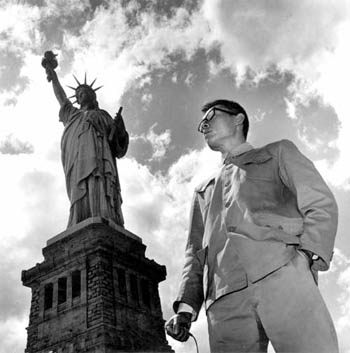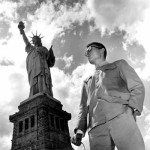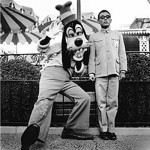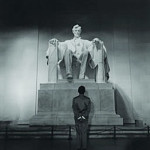By BEN SLOAT
At the Bernard Toale Gallery in the South End is a fascinating exhibition of photographic images, Ambiguous Ambassador, by the deceased photographer Tseng Kowng Chi. Each image is a staged self portrait, a square format black and white photograph of Tseng wearing a Chinese soldier’s uniform posing in a site of cultural importance. Known mostly for his images with Mickey Mouse at Disneyland, in front of the Notre Dame or the World Trade Center, this show at Bernard Toale Gallery includes fantastic pieces that have hardly been on exhibit before. More nature scenes are shown here, one particular image of note is of Tseng in a prairie field with ominous storm clouds approaching. Tseng’s work not only refocuses his importance as a pioneer, like Cindy Sherman, in the field of performative photographs, but reveals how culturally important his imagery continues to be.
Hong Kong-born Tseng Kwong Chi moved to New York City in the late 1970s. A photographer by trade, Tseng’s major photographic effort in America was the documentation of the public work and art activity of his friend and lover, Keith Haring, amassing an archive of over 50,000 images before their respective deaths in 1990.
His Ambiguous Ambassador project began in 1979 when Tseng bought a Maoist-era Communist uniform at a thrift store to wear for a formal family dinner. He immediately discovered that the outfit garnered a wide variety of responses from people, from curiosity to deference to contempt. Wearing the costume in the art world context, he found that he would be mistaken for a Chinese diplomat by an undiscerning public and given access to the upper echelons of art society, including major openings at the Metropolitan Museum of Art. One such interaction at the Met had Tseng meeting Yves St. Laurent while in uniform and stunning the fashion designer with his excellent command of French (Tseng had gone to art school in Paris).
Describing the attitude of the art world as having "the pervasive ignorance of Westerners regarding Asia generally and China specifically,” Tseng began his photographic project conflating his appearance with those of iconic Western landmarks. For theAmbiguous Ambassador series, Tseng wore a crew cut, dark sunglasses, and an official looking I.D. badge, clipped to his breast pocket, with his image and the title emblazoned, “SlutforArt.” Making images of himself at sites such as the Grand Canyon, the Hollywood sign, and the Tower Bridge, Tseng attempted to conflate cultural perceptions within the confines of the photographic self portrait.
Perhaps his most memorable image is a double portrait with Mickey Mouse at Disneyland. Mickey faces one direction with his rigid wide-eyed smile, Tseng faces the other, steadfastly expressionless behind sunglasses. Both are trickster figures in uniform, but Tseng represents the mysterious (and almost sinister) cultural qualities that have been associated with China. In a larger sense, with a continued unsettled idea of what China is today, the photographs now work more powerfully then ever. They can hardly be read as historical objects, made a quarter century ago, when America had only a vague idea of that large country across the Pacific.
- Tseng Kwong Chi, New York, NY, gelatin silver print, 1979.
- Tseng Kwong Chi, Disneyland, CA, gelatin silver print, 1979.
- Tseng Kwong Chi, Washington, DC, gelatin silver print, 1982.
"Tseng Kwong Chi: Ambiguous Ambassador" was on view until September 28th at Bernard Toale Gallery, located at 450 Harrison Ave., Boston, MA
All images are courtesy of the Bernard Toale Gallery.







